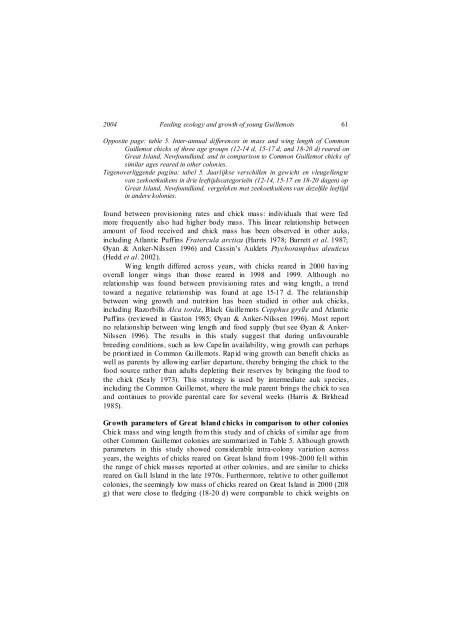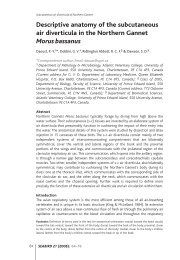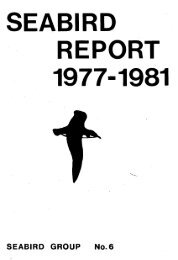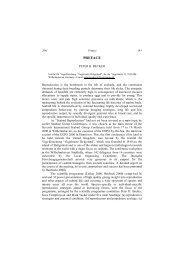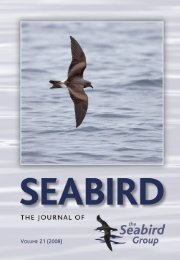Vol 6 No. 2 - The Seabird Group
Vol 6 No. 2 - The Seabird Group
Vol 6 No. 2 - The Seabird Group
Create successful ePaper yourself
Turn your PDF publications into a flip-book with our unique Google optimized e-Paper software.
2004 Feeding ecology and growth of young Guillemots 61<br />
Opposite page: table 5. Inter-annual differences in mass and wing length of Common<br />
Guillemot chicks of three age groups (12-14 d, 15-17 d, and 18-20 d) reared on<br />
Great Island, ewfoundland, and in comparison to Common Guillemot chicks of<br />
similar ages reared in other colonies.<br />
Tegenoverliggende pagina: tabel 5. Jaarlijkse verschillen in gewicht en vleugellengte<br />
van zeekoetkuikens in drie leeftijdscategorieën (12-14, 15-17 en 18-20 dagen) op<br />
Great Island, ewfoundland, vergeleken met zeekoetkuikens van dezelfde leeftijd<br />
in andere kolonies.<br />
found between provisioning rates and chick mass: individuals that were fed<br />
more frequently also had higher body mass. This linear relationship between<br />
amount of food received and chick mass has been observed in other auks,<br />
including Atlantic Puffins Fratercula arctica (Harris 1978; Barrett et al. 1987;<br />
Øyan & Anker-Nilssen 1996) and Cassin’s Auklets Ptychoramphus aleuticus<br />
(Hedd et al. 2002).<br />
Wing length differed across years, with chicks reared in 2000 having<br />
overall longer wings than those reared in 1998 and 1999. Although no<br />
relationship was found between provisioning rates and wing length, a trend<br />
toward a negative relationship was found at age 15-17 d. <strong>The</strong> relationship<br />
between wing growth and nutrition has been studied in other auk chicks,<br />
including Razorbills Alca torda, Black Guillemots Cepphus grylle and Atlantic<br />
Puffins (reviewed in Gaston 1985; Øyan & Anker-Nilssen 1996). Most report<br />
no relationship between wing length and food supply (but see Øyan & Anker-<br />
Nilssen 1996). <strong>The</strong> results in this study suggest that during unfavourable<br />
breeding conditions, such as low Capelin availability, wing growth can perhaps<br />
be prioritized in Common Guillemots. Rapid wing growth can benefit chicks as<br />
well as parents by allowing earlier departure, thereby bringing the chick to the<br />
food source rather than adults depleting their reserves by bringing the food to<br />
the chick (Sealy 1973). This strategy is used by intermediate auk species,<br />
including the Common Guillemot, where the male parent brings the chick to sea<br />
and continues to provide parental care for several weeks (Harris & Birkhead<br />
1985).<br />
Growth parameters of Great Island chicks in comparison to other colonies<br />
Chick mass and wing length from this study and of chicks of similar age from<br />
other Common Guillemot colonies are summarized in Table 5. Although growth<br />
parameters in this study showed considerable intra-colony variation across<br />
years, the weights of chicks reared on Great Island from 1998-2000 fell within<br />
the range of chick masses reported at other colonies, and are similar to chicks<br />
reared on Gull Island in the late 1970s. Furthermore, relative to other guillemot<br />
colonies, the seemingly low mass of chicks reared on Great Island in 2000 (208<br />
g) that were close to fledging (18-20 d) were comparable to chick weights on


